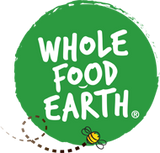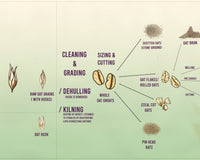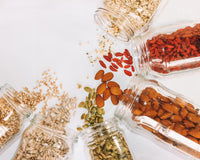When defining the concept of whole foods, we are looking at foods that have either not, or barely been processed or refined. Healthy whole foods are natural products that do not contain any artificial substances or additives. They are as natural and as organic as we can get in the food world.
Some of these food staple examples include fresh vegetables and fruits, dried fruits, frozen fruits, natural (unflavoured) yoghurts, fish, legumes, pulses, organic nuts, whole grains (barley, oats, brown rice), beans, eggs, and cheese.
Working off a whole foods diet may also include limiting, or dodging animal based products or foods with large amounts of fats, sugars, and salts.
Why are whole foods so beneficial for our health?
As one would assume, whole foods come with plenty of advantages. Whole food products work with your body and can help you intake a good amount of key nutrients and minerals to keep you in optimal health.
Interestingly, these products contain phytochemicals (linked to the natural colouring found in vegetables, fruit, and other foods) which contain beneficial resources for the body, that vitamins and minerals can’t necessarily produce, making it a great added bonus for those accumulating whole foods in to their diet.
Phytochemicals have been linked to things like lowering body mass, lowering the risk of vascular diseases, and lowering the future risk of some cancers.
Whole foods you should have in your pantry
Here are some examples of phytochemicals and their aids:
Flavonoids- These types of cells are found in a range of foods and provide anti-inflammatory qualities. (Cocoa, apples, onions, scallions, broccoli, kale, celery, hot peppers, thyme, parsley, teas, soybeans, and legumes)
Anthocyanidins- Pigment compounds found in many red/blue/purple berries, grapes and red wine.
Carotenoids- Pigment compounds found in many yellow/red/orange and citrus fruits and vegetables that have antioxidant qualities. (Carrots, tomatoes, bell peppers)
Lignans- Compounds found in plants that can help lower your risk of heart disease and osteoporosis (weakened bones), as well as naturally lowering menopause symptoms, and the potentiality of helping prevent breast cancer. (Seeds, whole grains, flaxseeds, and legumes)
Phytosterols- Compounds found in plants that can help lower your cholesterol, which is great for preventing diabetes and future obesity. (Olive oil, nuts, peas, kidney beans, and soy beans)
Stilbenoids- Found in the skin of lots of fruits and nuts like peanuts, grapes and berries. They work towards helping with depigmentation, inflammation issues and can work well with providing neuroprotection.
What happens to your body when you start eating more whole foods?
Whole foods are known to be rich in dietary fibres. These fibres are naturally occurring in plant-based products that reduce cardiovascular problems and support diabetes control.
With a greater inclusion of these rich fibres and phytochemicals, your diet will start to include the ideal consumption of elements like calcium, iron, omega three, vitamins D and B12. These are simple but powerful essentials, that we very easily do not get enough of in our day-to-day regime.
The addition of these whole food staples will also support you in many other ways, as well as just scientifically and chemically helping you. These food choices will support and develop a healthier metabolic rate, reduce risks of develop chronic conditions, improve your gut health, allow you to feel lighter, and feel less bloated, and potentially aid your hormonal and emotional health.
However, depending on what whole-food route you decide to take up, you could potentially be at risk at missing some key elements that your body was used to. For example, those living a vegan whole food diet, remove- meats, fish, and other products required from animals. This decision could lead to a lower intake of calcium, omega-three fatty acid, docosahexaenoic acids, and vitamin B12. This, therefore, makes it very important to research what alternatives you can switch into your diet, so you get the best results overall.
Are there any whole-food snacks?
As great as organic whole foods are for our health, alone, they do not necessarily have the same excitement attached to the concept of actually eating them. It can be a struggle trying to get fruits and veg into everyday diets when the competition has so much clever marketing attached it.
Who wouldn’t want a triple chocolate cookie that is sold with a fun flashy name, and exciting packaging, over a boring pack of organic carrots, for example! Carrots may well help me see in the dark, but are they really going to give me the same dopamine kick that the cookie will? I highly doubt it.
This is where whole food snacks come in to save the day! These healthier products don’t have to be stereotypically boring. With a little bit of effort, you can find exciting snacks in the shops, and online. You could even make some yourself with kitchen cupboard foods you already own.
Some stimulating, at home snacks you can make yourself, include fruit and veggie skewers, veggie crisps, peanut butter protein bites, fish-free sushi pieces, chia puddings, popcorn, nut and cocoa mixes, dried fruit pick-and-mixes, and much much more! There are plenty of these whole foods online, with heaps of recipes made to make your life easier.
Where can you buy whole foods?
With all of this information on what foods work for the body and what is good to buy, the next step is figuring out where to get these ingredients from. There are lots of options of where and how. Whole foods are sold in lots of smaller local shops that focus on organic ingredients. Bigger supermarkets are far more limited as they focus on branded and packaged foods. That is where you would find those triple chocolate cookies I mentioned earlier!
However, thanks to our contemporary world, we now have options to buy whole foods online. So, if you can’t find any local stores near you, check online to see if you can find your whole foods list there.






